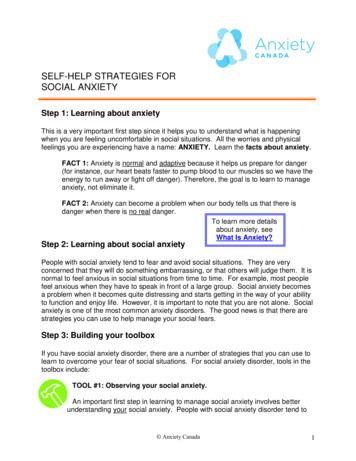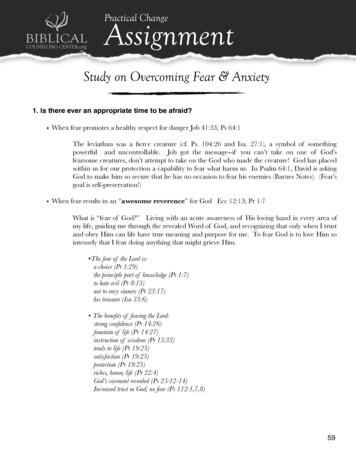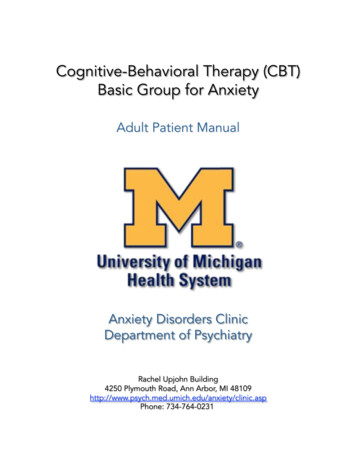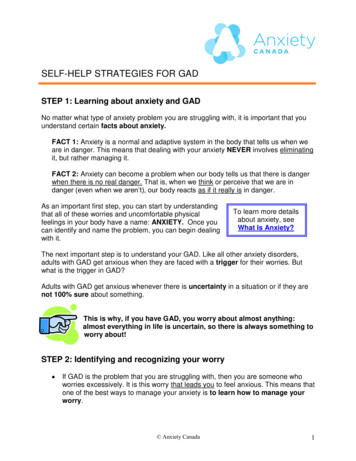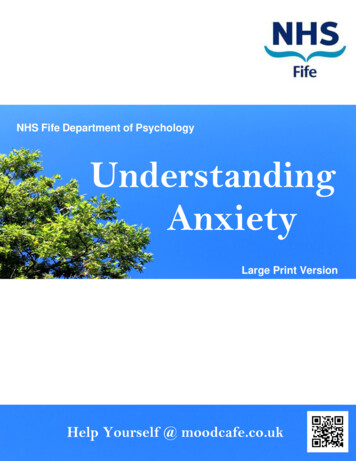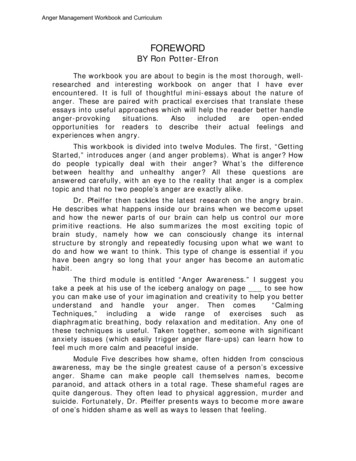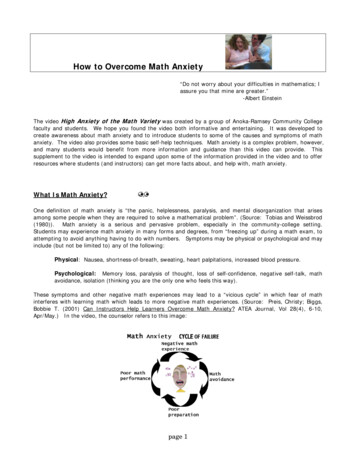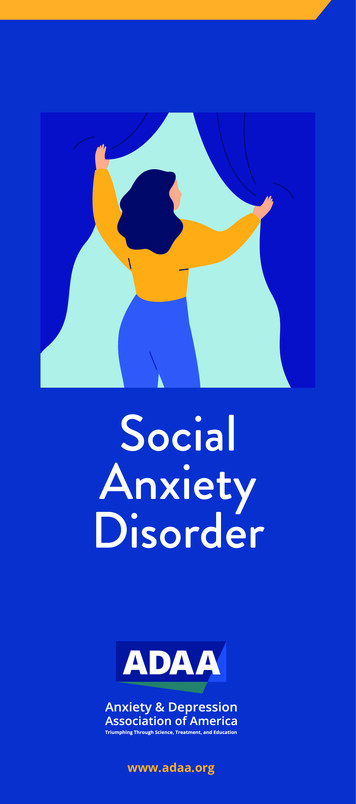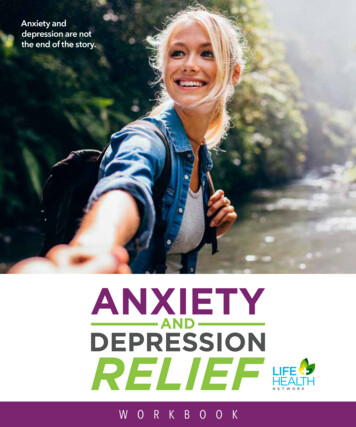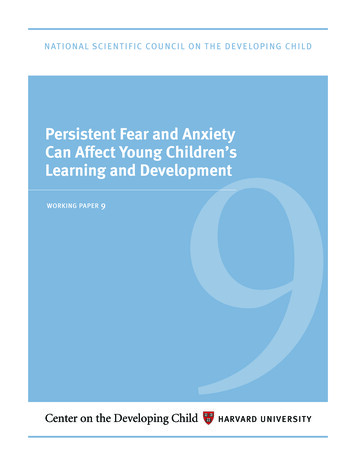
Transcription
9Persistent Fear and AnxietyCan Affect Young Children’sLearning and Developmentworking paper9
memberscontributing membersJack P. Shonkoff, M.D., ChairJulius B. Richmond FAMRI Professor of Child Health andDevelopment, Harvard School of Public Health and HarvardGraduate School of Education; Professor of Pediatrics,Harvard Medical School and Children’s Hospital Boston;Director, Center on the Developing Child, Harvard Universitysusan nall balesPresident, FrameWorks InstitutePat Levitt, Ph.D., Science DirectorDirector, Zilkha Neurogenetic Institute; Provost Professor ofNeuroscience, Psychiatry & Pharmacy; Chair, Department ofCell and Neurobiology, Keck School of Medicine, University ofSouthern CaliforniaW. Thomas Boyce, M.D.Sunny Hill Health Centre/BC Leadership Chair in ChildDevelopment; Professor, Graduate Studies and Medicine,University of British Columbia, VancouverJudy Cameron, Ph.D.Professor of Psychiatry, University of PittsburghGreg J. Duncan, Ph.D.Distinguished Professor, Department of Education,University of California, IrvineNathan A. Fox, Ph.D.Distinguished University Professor; Director, ChildDevelopment Laboratory, University of Maryland College ParkMegan Gunnar, Ph.D.Regents Professor and Distinguished McKnight UniversityProfessor, Institute of Child Development, Universityof MinnesotaLinda C. Mayes, M.D.Arnold Gesell Professor of Child Psychiatry, Pediatrics, andPsychology, Yale Child Study Center;Special Advisor to the Dean, Yale School of MedicineBruce S. McEwen, Ph.D.Alfred E. Mirsky Professor; Head, Harold and MargaretMilliken Hatch Laboratory of Neuroendocrinology,The Rockefeller Universityphilip a. fisher, ph.D.Professor of Psychology, University of OregonSenior Research Scientist, Oregon Social LearningCenter & Center for Research to Practicewilliam greenough, ph.D.Swanlund Professor of Psychology, Psychiatry, and Cell andDevelopmental Biology; Director, Center for Advanced Studyat University of Illinois, Urbana-Champaigneric knudsen, ph.D.Edward C. and Amy H. Sewall Professor of Neurobiology,Stanford University School of MedicineDeborah phillips, ph.D.Professor of Psychology and Associated Faculty, Public PolicyInstitute; Co-Director, Research Center on Children in the U.S.,Georgetown Universityarthur J. rolnick, ph.D.Senior Vice President and Director of Research, FederalReserve Bank of Minneapolispartnersthe frameworks institutethe national governors association center for best practicesthe national conference of state legislaturessponsorsthe birth to five policy alliancethe buffett early childhood fundPalix foundationCharles A. Nelson III, Ph.D.Richard David Scott Chair in Pediatric DevelopmentalMedicine Research, Children’s Hospital Boston; Professor ofPediatrics and Neuroscience, Harvard Medical SchoolRoss Thompson, Ph.D.Professor of Psychology, University of California, DavisAbout the AuthorsThe National Scientific Council on the Developing Child, housed at the Center on the Developing Child at Harvard University, is amulti- disciplinary collaboration designed to bring the science of early childhood and early brain development to bear on publicdecision- making. Established in 2003, the Council is committed to an evidence-based approach to building broad-based public will thattranscends political partisanship and recognizes the complementary responsibilities of family, community, workplace, and government topromote the well-being of all young children. For more information, go to www.developingchild.net.Please note: The content of this paper is the sole responsibility of the Council and does not necessarily represent the opinions ofthe funders or partners.Suggested citation: National Scientific Council on the Developing Child (2010). Persistent Fear and Anxiety Can Affect Young Children’sLearning and Development: Working Paper No. 9. http://www.developingchild.net February 2010, National Scientific Council on the Developing Child, Center on the Developing Child at Harvard University
The Issueensuring that young children have safe, secure environments in which to grow, learn,and develop healthy brains and bodies is not only good for the children themselves but also buildsa strong foundation for a thriving, prosperous society. Science shows that early exposure to circumstances that produce persistent fear and chronic anxiety can have lifelong consequences bydisrupting the developing architecture of the brain. Unfortunately, many young children are exposed to such circumstances. While some of these experiences are one-time events and others mayreoccur or persist over time, all of them have the potential to affect how children learn, solve problems, and relate to others.All children experience fears during childhood, including fear of the dark, monsters, and strangers.These fears are normal aspects of development andare temporary in nature. In contrast, threateningcircumstances that persistently elicit fear and anxiety predict significant risk for adverse long-termoutcomes from which children do not recover easily. Physical, sexual, or emotional abuse; significantmaltreatment of one parent by the other; and thepersistent threat of violence in the community areexamples of such threatening circumstances in achild’s environment.Studies show that experiences like abuse andexposure to violence can cause fear and chronicanxiety in children and that these states trigger extreme, prolonged activation of the body’sstress response system. In studies with animals,this type of chronic activation of the stresssystem has been shown to disrupt the efficiencyof brain circuitry and lead to both immediateand long-term physical and psychological problems. This is especially true when stress-systemoverload occurs during sensitive periods of braindevelopment. While much of the evidence forthe effects of stress on the development of brainarchitecture comes from animal studies, strongsimilarities in the processes of brain development across species indicate that experiencesof persistent fear and chronic anxiety likely exert similarly adverse impacts on the developingbrain in humans. Thus, stress-system overloadcan significantly diminish a child’s ability tolearn and engage in typical social interactionsacross the lifespan.Many policymakers, educators, and evenmedical professionals are unaware of the potentially significant, long-term risks of exposure tofear-provoking circumstances in children andwww.developingchild.NETlack information about the prevalence of thesesituations in their communities. Critically, 1 inevery 7 children, and nearly 1 out of every 40infants, in the United States experience someform of maltreatment, including chronic neglect or physical, emotional, or sexual abuse.1,2Child maltreatment has been shown to occurmost often in families that face excessive levelsof stress, such as that associated with community violence, parental drug abuse, or significant social isolation.3 Research also tells us thatnearly half of children living in poverty witnessviolence, or are indirectly victims of violence.1Clearly, for children in these circumstances, thefrequent and repetitive threats around themScience shows that exposure to circumstancesthat produce persistent fear and chronic anxietycan have lifelong consequences by disrupting thedeveloping architecture of the brain.create the potential for heightened fear andchronic anxiety.Behavioral neuroscience research in animals tells us that serious, fear-triggering experiences elicit physiological responses that affectthe architecture of the brain as it is developing.These experiences cause changes in brain activity and have been shown to have long-term, adverse consequences for learning, behavior, andhealth. Studies show that solutions for childrenare available through programs that effectivelyprevent specific types of fear-eliciting events,such as physical or sexual abuse. The timelyPersistent Fear and Anxiety Can Affect Young Children’s Learning and Development1
National scientific council on the developing childimplementation of such interventions can prevent and treat the harmful effects of exposureto extreme, fear-eliciting circumstances. In addition to these preventive measures, there alsoare effective treatments for children experiencing high levels of anxiety or chronic fear thatresult from serious emotional trauma. Despitethis rapidly increasing knowledge base, however, significant gaps continue to exist in howsociety responds to the developmental needs ofchildren who regularly experience serious, fearinducing events.What Science Tells Ussome types of fear are normal aspects ofdevelopment. Infants begin to experience feelings of fear and differentiate them from otheremotions between 6 and 12 months of age.4,5Over the course of the early childhood period,toddlers and preschoolers typically express fearof a wide variety of events or individuals. For example, it is not unusual for a young child to react with wariness or distress when greeted by anunfamiliar adult. Such responses are often called“stranger anxiety” and typically first emerge ataround 9 or 10 months of age. This hesitancytoward unfamiliar people generally continuesthroughout childhood, but diminishes overtime, as children’s social worlds expand and theyinteract with increasing numbers of caregivers,relatives, neighbors, and other familiar adults.Later in early childhood, it is common forchildren to express fear of both imagined andreal circumstances. The emergence and development of imagination, for example, may lead tofear of monsters or the dark. These reactions areThe emergence and course of typicalchildhood fears are different from the fears andanxiety elicited by traumatic situations such asphysical or sexual abuse or exposure to violence.for why children outgrow these normative fears.Many fears are a result of the difficulty youngchildren have in distinguishing between the realand the imaginary. As they get older, children getbetter at understanding what is real and what itmeans for something to be “make believe.” Atthe same time, they develop a growing sense ofcontrol and predictability over their immediateenvironment, so that even very young childrenare less frightened by events if they have somecontrol over them. For example, a toy that scares12-month-olds because it is loud and unpredictable will elicit less fear if the children are shownhow to turn it on and off and are allowed to doso.6 As they get older, children develop the cognitive and social skills needed to better understand predictability in their environment and,therefore, gain a greater sense of control. As thesedevelopmental capacities are mastered, many ofthe normal fears of childhood begin to disappear. Thus, the emergence and course of typicalchildhood fears are different from the fears andanxiety elicited by traumatic situations such asphysical or sexual abuse or exposure to violence:While typical fears disappear with age, the fearand anxiety elicited by maltreatment and otherthreatening circumstances do not.Early exposure to extremely fearful events affectsthe developing brain, particularly in those areas involved in emotions and learning. A large and grow-typical and usually peak between 4 and 5 years ofage. Generally speaking, normal preschool fearsdo not disrupt a child’s life, and they dissipateby age 7 or 8. That is, while children may expressthese fears at certain times (e.g., bedtime) or inresponse to certain events (e.g., being surprisedby a clown at a birthday party), their overall behavior does not otherwise suggest that they aregenerally fearful or distressed.Scientific research provides an explanationing body of research, including animal studies aswell as recent neuroimaging studies of humanadults, has revealed groundbreaking insights intothe brain circuitry that underlies how we learn tobe afraid 7,8 and how we come to associate a specific event or experience with negative outcomes.9,10Two extensively studied structures located deep inthe brain—the amygdala and the hippocampus—are involved in fear conditioning.9,10 The amygdaladetects whether a stimulus, person, or event isthreatening 9,10 and the hippocampus links the fear2 Persistent Fear and Anxiety Can Affect Young Children’s Learning and Developmentwww.developingchild.NET
What science Tells Usresponse to the context in which the aversive stimulus or threatening event occurred.11 Studies alsoshow that both the amygdala and the hippocampus play an important role in how the body thenresponds to this threat. Elevated stress hormonessuch as cortisol have been shown to affect thegrowth and performance of the hippocampus andthe activity of the amygdala in rodents and nonhuman primates, and early and persistent activation of the stress response system adversely affectsbrain architecture in these critical regions.Beyond its impact on these two brain structures, heightened stress has also been shownin animals to impair the development of theprefrontal cortex, the brain region that, in humans, is critical for the emergence of executivefunctions—a cluster of abilities such as making, following, and altering plans; controllingand focusing attention; inhibiting impulsivebehaviors; and developing the ability to holdand incorporate new information in decisionmaking. These skills become increasingly important throughout the school years and intoadulthood. Behavioral neuroscience researchin animals tells us that the prefrontal cortex ishighly sensitive to the detrimental effects of excessive stress exposure and that its developingarchitecture is vulnerable to the negative effectsof chronic fear.12When young children experience serious feartriggering events, they learn to associate thatfear with the context and conditions that accompanied it. Very young children can actually learnwithin the context in which the learning occurred.For example, a child who is physically abusedby an adult may become anxious in responseto both the person and the place where the fearFor young children who perceive the world as athreatening place, a wide range of conditions cantrigger anxious behaviors that then impair theirability to learn and to interact socially with others.learning occurred. Over time, the fear elicitedand the consequent anxiety can become generalized, and subsequent fear responses may be elicited by other people and places that bear sometimes only small resemblances to the originalconditions of trauma. Consequently, for youngchildren who perceive the world as a threatening place, a wide range of conditions can triggeranxious behaviors that then impair their abilityto learn and to interact socially with others. Theextent to which these problems affect physicaland mental health is influenced by the frequencyof the stressful exposure and/or the emotionalintensity of the fear-eliciting event.Science tells us that unlearning fear is a fundamentally different process from fear learning.to be fearful through a process called “fear conditioning,” which is strongly connected to thedevelopment of later anxiety disorders.13,14,15,16In the typical circumstances of early childhood,fear responses are activated quickly and thendissipate. However, when young children arechronically exposed to perceived or real threat,fear-system activation can be prolonged. In research studies, fear conditioning involves thepairing of a neutral stimulus (e.g., a tone or alight) that normally does not elicit a negativeemotional response with an aversive stimulus(e.g., pain) that produces fear. As this conditioning evolves, it solidifies the relation between the two stimuli and then generalizes thefear response to other neutral stimuli that mayshare similar characteristics with the aversivestimulus. Conditioned fear is apparent whenindividuals come to experience and express fearThe process of unlearning conditioned fear iscalled “extinction” and actually involves physically separate and distinct areas of the brain’s architecture from those into which fear responsesare first incorporated. Generally speaking, theunlearning process involves activity in the prefrontal cortex, which decreases the fear responseby regulating the activity of the amygdala.17,18,19,20Research tells us that fears are not just passivelyforgotten over time, but they must be activelyunlearned. Studies show that fear learning canoccur relatively early in life,21,22,23 whereas fearunlearning is only achieved later, when certainstructures in the brain have matured.24,25 Consequently, early fear learning can have a significantimpact on the physical and mental health of ayoung child that can take years to remediate.This understanding of how fear unlearningoccurs can be helpful in designing interventionsfor anxious and fearful children. For example,research has shown that unlearning negative fear responses to specific stimuli such aswww.developingchild.NETPersistent Fear and Anxiety Can Affect Young Children’s Learning and Development3
National scientific council on the developing childChronic and intense fear early in life affects thedevelopment of the stress response system andinfluences the processing of emotional memories.26,27 When an individual is confronted witha threat, stress systems are activated and elevatethe levels of several different stress chemicalsthat are circulating throughout the body.28,29An increase in one of those chemicals, cortisol,can have a dramatic impact on how memoriesare processed and stored.29,30 The production ofcortisol and adrenalin (as well as noradrenalinein the brain) in a normal stress response leadsto memory formation for events and placesthat generate danger. More specifically, elevatedcortisol levels can strengthen the formation ofmemories of emotional events,31,32 block theability to unlearn fear memories,33 and enhancethe formation of memories of the surroundingcontext in which the fearful event occurred.34 Interestingly, too much cortisol can also have theopposite effect and actually impair memory andlearning in non-threatening contexts.35 Thus,the biological response to stress is intimately involved in both fear learning and unlearning.Persistent Fear and Anxiety Can Affect Young Children’s Learning and Developmentwww.developingchild.netillUSTraTion BY BeTSY haYeSanimals, insects, heights, or social situations canbe accomplished successfully by presenting theaversive stimulus or circumstance at a low levelof intensity while the fearful individual is in asafe context. This therapeutic approach is calledcognitive behavioral therapy. Providing additional explanations for anxious behavior duringthese controlled exposures has proven to be particularly successful for reducing anxiety in olderchildren with excessive fears, as their ability tounderstand these explanations develops. Suchinterventions work well with specific phobias,as well as social or generalized anxiety, but arenot effective in remediating the effects of abuseor neglect.4
What science Tells UsFear learning can form emotional memories that are extremely powerful and long lasting. These memories are relived by individualswho experienced a traumatic event when cuesin the environment activate those memories.This repeated recall or retrieval of the memorymakes emotional memories both more easilyactivated and more resistant to being forgotten.29,30 The repeated recall of a traumatic eventcan lead to additional release of cortisol, even inthe absence of the actual event. Behavioral neuroscience research with animals has shown thatchronic elevation of cortisol can have a numberof detrimental effects, including increased damage to brain cells in areas that support learning,thereby leading to increased impairment in subsequent memory formation.30,31Persistent fear can distort how a child perceives andresponds to threat. Fear learning typically takesplace in specific contexts and results in those fearsbecoming associated with the places where thelearning occurred. Children may also express fearin response to situations that are similar (not identical) to those initially learned or to situations thatare similar to the contexts in which the originallearning occurred. These are called “generalized”fear responses, and they are thought to underliethe expression of later anxiety disorders, includingpost-traumatic stress disorder (PTSD).15,36,37 Thus,although all individuals display a heightened fearresponse when faced with threatening contexts,36,38individuals with anxiety disorders show this sameincreased fear response when faced with similarcontexts that are known to be safe.36,38,39 Indeed,children who have had chronic and intense fearfulexperiences often lose the capacity to differentiatebetween threat and safety. This impairs their abilityto learn and interact with others, because they frequently perceive threat in familiar social circumstances, such as on the playground or in school.These responses inhibit their ability to learn andoften lead to serious anxiety disorders.40,41Young children who have been exposed totraumatic circumstances also have difficultyidentifying and responding to different expressions of emotions, and, therefore, have troubleforming healthy relationships.42,43,44,45,46 Thesedeficits lead to general problems with socialinteraction, such as understanding others’ facialexpressions and emotions. For example, children raised in physically abusive householdsshow heightened sensitivity (compared withwww.developingchild.netnon-abused children) to angry faces, whichnegatively affects their brain function and behavior.47,48,49,50 Learning to identify anger—quickly and successfully—in order to avoid being harmed is a highly adaptive and appropriateresponse to an abusive environment. However,an increased tendency to assume someone isangry when his or her facial expression is ambiguous can be inappropriate and maladaptiveChildren who have had chronic and intensefearful experiences often lose the capacity todifferentiate between threat and safety.in a typical, non-threatening social setting andeven dangerous in unfamiliar social settings.51This “attention bias” to threat is associated withinterpreting ambiguous information in a negative fashion, and it is linked to greater vulnerability to stress and anxious behaviors as well asto a greater likelihood to respond aggressively asa form of self-defense in neutral circumstancesthat are erroneously viewed as threatening. Thus,the extent to which children with a heightenedattention bias to threat view the world as a hostile and threatening place can be viewed as botha logical adaptation to an abusive environmentand a potent risk factor for behavior problemsin later childhood, adolescence, and adult life.Early exposure to intense or persistent feartriggering events affects children’s ability tolearn. There is extensive and growing scientificevidence that prolonged and/or excessive exposure to fear and states of anxiety can causelevels of stress that can impair early learning andadversely affect later performance in school, theworkplace, and the community. Multiple studiesin humans have documented problems in cognitive control and learning as a result of toxicstress.52,53 These findings have been strengthenedby research evidence from non-human primatesand rodents that is expanding our understanding of the brain mechanisms underlying thesedifficulties.The brain region in animals that appearshighly vulnerable to adversity in this regardis the prefrontal cortex, which is the critical area for regulating thought, emotions, andactions as well as for keeping information readilyPersistent Fear and Anxiety Can Affect Young Children’s Learning and Development5
National scientific council on the developing childaccessible during the process of active learning. For example, researchers have found thatelevations in brain chemicals like noradrenline,an important neurotransmitter, can impairfunctions that are controlled by the prefrontalregion by altering the activity of neurons in thatarea of the brain. In a related fashion, humansexperiencing chronic stress have been shown toperform poorly on tasks related to prefrontalcortex functioning (such as working memory orshifting attention), and their ability to controltheir emotions is typically impaired.12Correcting Popular Misrepresentations of Sciencethere are a number of widespread misconceptions about how children experience, respond to, and learn fear. Many of these assumptions derive from overgeneralizations of whatfears are typical at specific developmental stagesas well as misunderstandings about what children can simply “outgrow” as they mature. Beingafraid of strangers and monsters are commonexamples of typical fears. In contrast, researchhas demonstrated convincingly that excessivefear and anxiety caused by experiences suchas abuse and neglect can affect the developingchild in very different ways from the fear experiences that characterize a typical childhood.Contrary to popular belief, serious fear-triggeringevents can have significant and long-lasting impacts on the developing child, beginning in infancy. Science tells us that young children can perceivethreat in their environment but, unlike adults, theydo not have the cognitive or physical capacities toregulate their psychological response, reduce thethreat, or remove themselves from the threatening situation. Research also shows that very younginfants can learn to fear certain places, events, orpeople. These learned fear responses may disruptthe physiology of the stress response system, making it more difficult for the body to respond appropriately to typical, mild stress in everyday contextslater in life. Furthermore, when fear is learned,normal situations and circumstances can elicit responses that are harmful to a child’s development.Children do not naturally outgrow early learnedfear responses over time. Fear learning early inlife can often be adaptive—think about howa young child learns to stay away from hotsurfaces. Thus, fear learning and associated6 Persistent Fear and Anxiety Can Affect Young Children’s Learning and Developmentmemories that occur early in life get built intoour brain architecture and do not dissipate withage. During typical development, children learnto regulate their responses to mild threats andstresses. However, if young children are exposedto persistent fear and excessive threat duringparticularly sensitive periods in the developmental process, they may not develop healthypatterns of threat/stress regulation. Whenthey occur, these disruptions do not naturallydisappear.Simply removing a child from a dangerous environment will not by itself undo the serious consequences or reverse the negative impacts of earlyfear learning. There is no doubt that children inharm’s way should be removed from a dangeroussituation. However, simply moving a child outof immediate danger does not in itself reverseor eliminate the way that he or she has learnedto be fearful. The child’s memory retains thoselearned links, and such thoughts and memoriesare sufficient to elicit ongoing fear and make achild anxious. Science clearly shows that reducing fear responses requires active work and evidence-based treatment. Children who have beentraumatized need to be in responsive and secureenvironments that restore their sense of safety,control, and predictability—and supportive interventions are needed to assure the provisionof these environments. Thus, it is critical thatcommunities be equipped to address the sourcesof fear in children’s lives. Where indicated, children with anxiety can benefit from scientificallyproven treatments, such as cognitive behavioral therapy, which have been shown to reduceanxiety and fear.www.developingchild.net
the science-policy gapThe Science-Policy GapAdvances in the science of child developmenttell us that significant fear-eliciting experiencesearly in life can disrupt the typical developmentof stress regulation as well as learning, memory,and social behavior, yet there is still widespreadresistance in the policy arena to fully addressingthe needs of young children who have been traumatized. Building on decades of evidence frombehavioral research, it is now abundantly clearthat young children who are exposed to circumstances that produce persistent fear are atheightened risk for anxiety disorders and othermental health problems that persist into adulthood. Concurrently, a variety of prevention andearly intervention programs have been developed to address the needs of young children whohave been exposed to such fearful situations asphysical abuse or family violence. The limitedavailability of these kinds of programs for veryyoung children represents a striking failure torelieve immediate distress as well as prevent serious and costly long-term disability.The lack of availability of adequate health insurance to cover the cost of therapeutic treatmentfor young children who are experiencing persistent fear and chronic anxiety represents a significant lost opportunity to ameliorate preventableimpairments in physical and mental health thatcan have lifelong implications. The science ofchild development points the way toward effective approaches to the treatment of childrenwith excessive anxiety and fear. These methods,if administered early, can reduce the incidenceof anxiety disorders in children and prevent thekinds of elevated stress responses that lead tophysical and mental health impairments laterin life. Addressing the current gaps among whatscience knows about effective treatments, whatis available in health care and early childhoodsettings, what is covered by health insurance,and the availability of coverage for all childrenneeds to be an important policy priority.Policy ImplicationsPrograms and policies that are designed to address domestic violence, substance abuse, andmental health problems in adults who have (orare expecting) children would have considerablystronger impacts if their focus also included thechildren’s developm
prevent specific types of fear-eliciting events, such as physical or sexual abuse. The timely . the issue. www.developingchild.neT . Persistent Fear and Anxiety Can Affect Young Children’s Learning and Development . 1. ensuring that young childre
